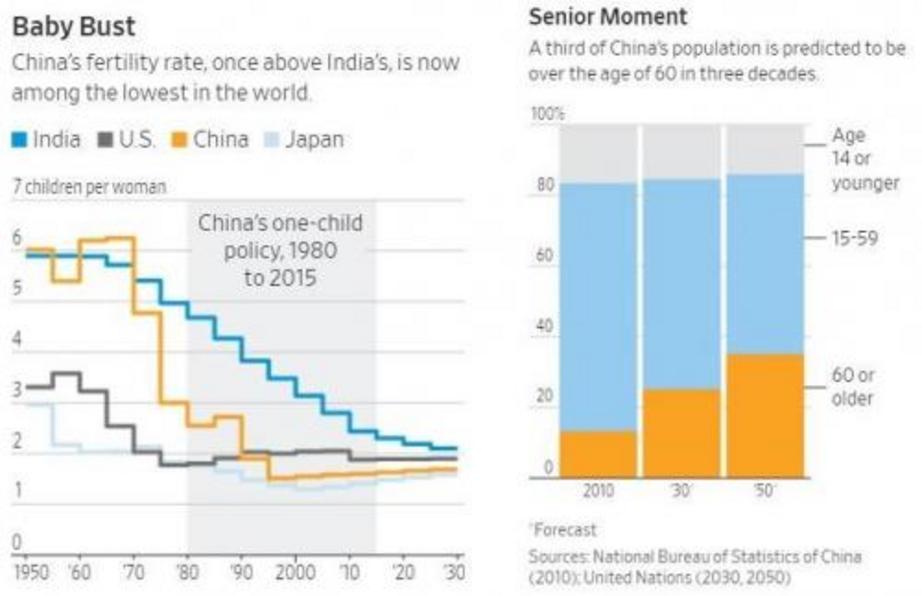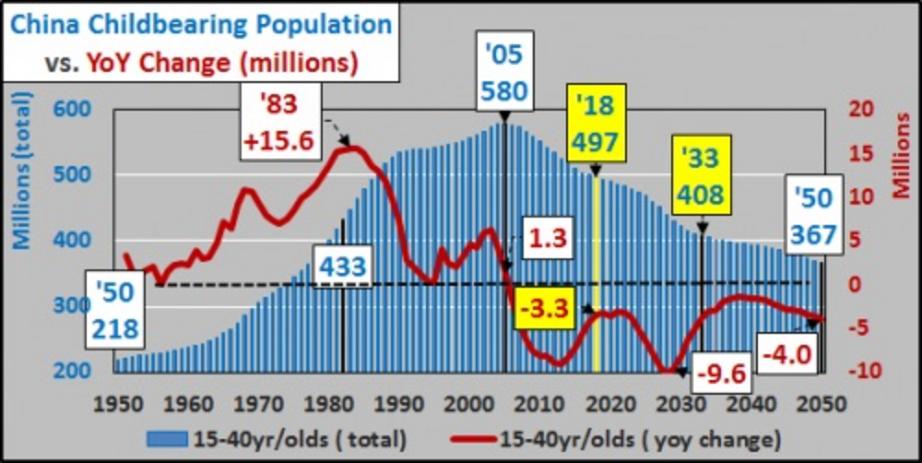"No longer reversible": China's low fertility rate and birth restrictions set stage for disaster
While China has embarked on ambitious plans for economic and military domination over the next several decades, they may end up defeating themselves without a single shot fired - thanks to their longstanding birth restrictions, shrinking fertility rate and exploding elderly population.

Economically speaking, the problem is easy to understand; a shrinking labor pool due to restrictive reproductive laws tends to drive up wages, while a rapidly growing elderly population requires more spending on pensions and health care. "In a worse-case scenario, slowing growth and a labor shortage could leave China unable to care for hundreds of millions of retirees," notes the Wall Street Journal.
"China’s clinging to birth restrictions defies a clear demographic trend: Its workforce is shrinking and the population is rapidly aging. By 2050, there will be 1.3 workers for each retiree, according to official estimates, compared with 2.8 now.
No matter what the government does now, it is too late to significantly change the overall trend because of social attitudes, say demographers such as Gu Baochang, a professor of demography at Renmin University in Beijing." -WSJ
While some experts have argued that slower population growth could mitigate pressure on China to create new jobs as technology increases productivity, others think China is in deep trouble...
“They should have lifted all birth restrictions before 2010,” says Baochang. “Whatever steps they take now, China’s low-fertility trend is no longer reversible.” In three decades, 1/3 of China's population is predicted to be over the age of 60.

The chart below shows annual change in million persons (red line) and total child bearing population (blue columns). From 2018 through 2033, China (with net emigration, to boot) will see an average annual decline of nearly 6 million Chinese capable of creating more Chinese (or the equivalent of losing the population of a Missouri, Wisconsin, or Maryland every year for at least the next decade and a half). -Chris Hamilton, Economica blog

Meanwhile, China's one-child policy, and now two-child policy, has conditioned the population to shun large families.
"In a generation that grew up without siblings, a one-child mind-set is deeply entrenched. Maternity-leave policies have been expanded but some women say taking leave twice is a career impediment. An All-China Women’s Federation survey found 53% of respondents with one child didn’t want a second.
Even without birth limits, China’s economic development would have reduced fertility rates, says Martin Whyte, a Harvard University Chinese-studies expert. That has been the pattern elsewhere in the world: When incomes rise, the sizes of families tend to go down." -WSJ
If the nation drops birth policies now, says Whyte, “China will learn what many other countries have learned—that it is much more difficult to get people to have more babies” than to force them to stop having them.
Rapid Aging
In May of 2017, Moody's cited China's rapidly aging population as a major factor in their decision to downgrade their sovereign rating, as an explosion in elder care is expected to erode household savings and strain government coffers - jeopordizing the government's already hefty debt load. The ratings agency predicted China's economic growth could potentially slow to around 5% over the next five years vs. a 2017 rate of 6.9%.
“China is really interesting and unique,” said Marie Diron, a Moody’s analyst of sovereign risk, “because it is aging so much earlier than anyone else.”
Compounding China's problem is the fact that it has one of the lowest retirement ages in the world, at 55 on average - while Beijing has been reluctant to implement a plan to gradually raise it.
"Officials had originally indicated they would present the plan last year. It was left out of measures unveiled at the congress in March, in which Beijing said the new ministry “will actively deal with the aging of the population,” with measures to develop the elderly-care sector and health-care reform.
Past policy changes haven’t fixed the trend—not even ending the one-child policy did. Newborns rose by 1.3 million in 2016, the first year without the policy—less than half the official projection—to 17.86 million, from 2015, according to the National Bureau of Statistics.
In 2017, births slowed to 17.23 million, well below the official forecast of more than 20 million." -WSJ
Breakin' the law
China's reluctance to further soften their tone on birth restrictions is also leading to friction within local communities and at the workplace.
"When Ms. Li, the Qingdao professor, refused to abort her third child, she said, her university employer accused her of selfishly putting at risk her supervisors’ careers, the school’s future and co-workers’ bonuses. A university spokeswoman didn’t respond to faxed inquiries.
With the help of local church friends, her family moved to the Philippines, where she gave birth in November." -WSJ
Other countries with shrinking workforces have tried to stave off economic disaster by raising retirement ages or relying on immigration. Singapore, for example, has very liberal immigration policies and offers a "baby bonus" as high as 10,000 Singapore dollars ($7,500) along with grants available for parents which can be used for healthcare and education.
Japan, meanwhile, has shuffled healthy retirees back into the workforce - along with various technological aides to make up for age-related deficiencies.
"In some cases, the solution lies in technologies that help offset senior workers’ deficiencies, like the exoskeletons used by Obayashi at its construction site. The Fujisawa Aikoen nursing home about an hour outside Tokyo started leasing the “hybrid assistive limb,” or HAL, exoskeletons from maker Cyberdyne Inc. in June.
At an office-building construction site in the center of Japan’s capital, 67-year-old Kenichi Saito effortlessly stacks 44-pound boards with the ease of a man half his age.
His secret: a bendable exoskeleton hugging his waist and thighs, with sensors attached to his skin. The sensors detect when Mr. Saito’s muscles start to move and direct the machine to support his motion, cutting his load’s effective weight by 18 pounds." -WSJ (2015)
"In Hokkaido, 60-year-old potato-pickers use rubber “smart suits” making it easier to bend over. Baggage handlers at Tokyo’s Haneda airport employ similar assistance," reports the Journal.
Back to China, President Xi Jinping has acknowledged the need to breed - stating in 2015 that China needs more births, while omitting a traditional reference to "family planning" in his party-congress report.
“I think Xi’s views about demography are clear: He considers population more as a resource than a burden,” said Huang Wenzheng, a researcher at the Center for China and Globalization, a Beijing-based independent think tank, and a co-founder of a hedge-fund firm that invests globally. “But of course he cannot easily abandon the family-planning policy because that would be a sharp turn away from

